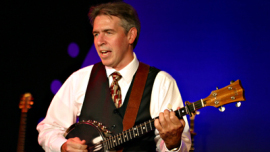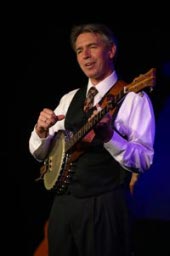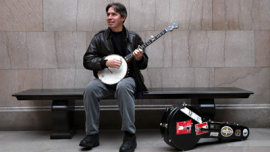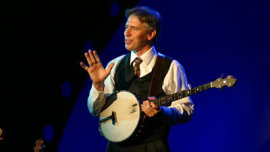 Michael
J. Miles, the freelance educator, composer, and musician currently in
the area as Quad City Arts' latest visiting artist, isn't blind
to the common associations connected with the banjo. "The general
awareness," he says, "if there is
any, of the banjo sits on
things like The Beverly
Hillbillies or Deliverance
or O
Brother, Where Art Thou?"
Michael
J. Miles, the freelance educator, composer, and musician currently in
the area as Quad City Arts' latest visiting artist, isn't blind
to the common associations connected with the banjo. "The general
awareness," he says, "if there is
any, of the banjo sits on
things like The Beverly
Hillbillies or Deliverance
or O
Brother, Where Art Thou?"
So when introducing his musical instrument of choice to audiences, be they adults or children, Miles likes to begin with a little history.
"The earliest documentation of the banjo in America is on slave ships," says Miles during a recent phone interview. "There's a journal from a guy named George Pincard, in 1796 ... . He's on a ship in the harbor of Carlisle Bay, Jamaica, and next to his ship is a slave ship, and on it there's a guy playing the banjo.
"And the sad truth," he continues, "is that slave traders discovered that having music and musicians on these ships lowered the mortality rate, so [traders] made sure to grab musicians and instruments. They became inadvertent importers of African music."
Miles understands that "the idea that the instrument came to America from Africa under duress, on slave ships, is a pretty shocking truth to take in," but the Chicago-based musician has devoted a significant portion of his career to revealing the long, colorful history of the banjo through educational outreach programs and such stage presentations as From Senegal to Seeger: Stories of the American Banjo. (Portions of the piece will be staged during Miles' public performance at Bettendorf's Redeemer Lutheran Church on December 13.)
Called "an exhilarating, musical, and multi-dimensional journey" by the Chicago Sun-Times, From Senegal to Seeger finds Miles covering some 300 years of songs, poetry, and protest in what his Web site (MilesMusic.org) describes as "a social and political portrait of America through the eyes of the banjo." Yet the program is also a portrait of the banjo itself, with demonstrations on how the instrument's sound can be employed in the service of folk, blues, and even Johann Sebastian Bach, plus a series of original compositions that, says the artist, are "kind of what drives me now.
"And," he adds with a laugh, "I think that Bach, in fact, might be more happy with that, as well."
On the Friendly Side
 The
youngest of five children, Miles says that while growing up in
Chicago, "Music was always part of the household. My father was a
blue-collar guy - he worked for the electric company - but he
bought himself a player piano, and he liked to sing old show tunes
and play 'em at his player piano after working all day."
The
youngest of five children, Miles says that while growing up in
Chicago, "Music was always part of the household. My father was a
blue-collar guy - he worked for the electric company - but he
bought himself a player piano, and he liked to sing old show tunes
and play 'em at his player piano after working all day."
Miles himself began playing the guitar, he says, "when I was maybe 12 or 13," and didn't pursue the banjo until he was an undergraduate at the University of Illinois. ("My high school didn't really have any music programs," he recalls, "so I sat kind of dormant, really, until I got to college.") He did, though, take an instant liking to it.
"Of all the instruments," says Miles of the banjo, "it's on the friendly side to start with, because if it's in tune, it's tuned to a chord. So if you strum without putting any fingers down on it, you can start to play one-chord songs right away." And having prior experience on the guitar, Miles was already familiar with the similarities between the instruments' chord structure, and how readily they lent themselves to different types of music.
"If you think of 'Twinkle Twinkle Little Star' as a simple little three-chord folk song," he says, "and then think of songwriters like Bob Dylan, the difference between 'Twinkle Twinkle Little Star' and 'Blowin' in the Wind' is not very great. I mean, they're using similar chord progressions. There's an entirely different feel, of course, but the complexity of it is not significantly different."
Yet Miles says that, from the start, the instrument's primary appeal was less its simplicity or sound than "kind of developing my own sound on the banjo," one that didn't jibe with traditional perceptions of how banjo music should be employed.
"I didn't grow up in the South, and so I wasn't really steeped in the southern-American musical traditions. Rather, it was my father singing show tunes, and as a kid growing up in the '60s and '70s, I was listening to rock and roll, and listening to classical music, and having my ears informed by all these different styles.
"So when it came around to the banjo," he says, "one of the first things I did, that no one had actually done before, was record the Bach cello suites."
Released in 1997, American Bach found Miles, on the banjo, performing Bach's first and third Suites for Unaccompanied Cello, each piece lasting some 20 minutes. It was a risky experiment, and Miles says that working on the project was like "gazing into the eyes of one of the wonders of the world. Actually putting my fingers on all of Bach's notes, and all of his ideas ... . It was quite exciting. I mean, some people have dabbled with Bach, but no banjo player had ever taken on entire suites before.
 "And
for good reason," he says with a chuckle, "because there's not
many people who want to hear
that, you know? There's a
little part of the world that likes the banjo, there's another
little part of the world that likes Bach, and the place where they
intersect is really tiny.
So it's not like my having done that brings in a great deal of
work.
"And
for good reason," he says with a chuckle, "because there's not
many people who want to hear
that, you know? There's a
little part of the world that likes the banjo, there's another
little part of the world that likes Bach, and the place where they
intersect is really tiny.
So it's not like my having done that brings in a great deal of
work.
"However," he adds, "my having done that made me a much better player, and a much more engaged musician, because of that experience of forcing myself to solve the musical riddles of 'How can I take Bach's melodies and put them on the banjo?'"
If American Bach's reviews are to be trusted, the musician solved the mystery. The Chicago Tribune's Howard Reich wrote, "Miles has dared to take on some of the most dramatic and profound music ever written ... and succeeded," while music critic Janos Starker called it "a remarkable feat," adding, "My first reaction to his playing was a smile, and then amazement." Miles believed that he had found a comfortable, if unusual, musical niche.
"I thought that was going to be an end unto itself," he says. "That I would be the guy who played Bach on the banjo."
Other Sides of the Banjo
What happened instead was Miles' immersion in Bach leading him to composing works of his own. "Having experienced his music," he says, "I discovered that what I could do was create my own melodies that were informed by what I'd learned from the process of learning Bach."
Though he eventually earned a master's degree in music performance on the guitar and banjo from Chicago's Northeastern Illinois University, "my undergraduate degree was in oral interpretation," says Miles, "which is a mixture of literary criticism and theatre." And those interests, combined with his love of music, dovetailed in his 1997 stage presentation The Magic Banjo, which subsequently morphed into Miles' current From Seeger to Senegal.
That oral-interpretation degree, says Miles, "is a big part of my work now. I do a lot of historical, musical documentaries for the stage that present music, history, politics, and literature together," and From Seeger to Senegal - described as "captivating, entertaining, and thoughtful" by the Milwaukee Journal Sentinel - certainly qualifies.
"It sort of tells the story of the banjo through music," says Miles of the program. "It's not trying to be a comprehensive history of it, but rather it's just sort of pointing to where it came from. Because most people don't even know that the banjo came from Africa." And with the presentation also featuring Miles performing selected writings by Pete Seeger, Walt Whitman, Carl Sandburg, Woody Guthrie, and Mark Twain, "it's also literary," he says, "basically showing other sides of the banjo."
Other styles, as well. The "Senegal" of the title refers to Miles' exploration of the banjo's history prior to its American arrival, and the program finds the musician showcasing - and performing on - banjos of varying shapes, sizes, sounds, and global regions. (In the full-length From Senegal to Seeger, Miles plays seven or eight different types of banjo, "three or four" of which the artist has brought with him to the Quad Cities.)
 "One
of the first musical instruments on the planet Earth was a drum,"
says Miles, "and the idea of the banjo's origin is that it's a
drum with strings. I have one from Senegal that only has three
strings. It's a hollowed out log - like a log that you'd throw
on a campfire - and then there's a leather top that goes over it,
so you can beat on it like a drum. But then there's a stick that
runs through it with a few strings attached, and it creates a very
dark, lower pitch. You know, you tend to think of banjos being kind
of jangly-, high-, kind of twangy-sounding,
and this one isn't. It's much darker."
"One
of the first musical instruments on the planet Earth was a drum,"
says Miles, "and the idea of the banjo's origin is that it's a
drum with strings. I have one from Senegal that only has three
strings. It's a hollowed out log - like a log that you'd throw
on a campfire - and then there's a leather top that goes over it,
so you can beat on it like a drum. But then there's a stick that
runs through it with a few strings attached, and it creates a very
dark, lower pitch. You know, you tend to think of banjos being kind
of jangly-, high-, kind of twangy-sounding,
and this one isn't. It's much darker."
Audiences may be surprised by the variety of banjos that Miles displays, but they're likely to be even more surprised by the variety of musical genres the instrument can lend itself to.
Beyond snippets of Bach, Miles says that "in concerts, I'll play Richard Thompson stuff," referring to the acclaimed British guitarist's output, "or I'll play Rolling Stones. I recorded the Rolling Stones' 'Sway,' which is the track after 'Brown Sugar.' Of course, it's a blues piece, and blues tends to work quite well [on the banjo]. And going from that into rock and roll - like some Beatles things - is doable."
Miles admits, though, that there are limits to what types of music the instrument can successfully pull off. "As you get into more complex chord structures, some of the nuance can be lost of the banjo, so it's not like you can do any song. I mean, there are some songs I would never try, and some songs that I do try and I think, 'Ew-w-w, this is not a banjo song.'"
He laughs and adds, "But the good news is that there's no end, you know? There's always more to tap into, and always more to learn if you want to, and that's what excites me about the banjo. You can study it forever."
Michael J. Miles performs at Bettendorf's Redeemer Lutheran Church (1107 Tanglefoot Lane) at 7 p.m. on Saturday, December 13. Admission is free, though donations will be accepted, and more information is available by visiting QuadCityArts.com.










